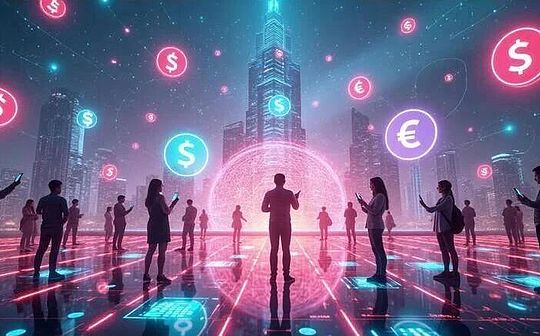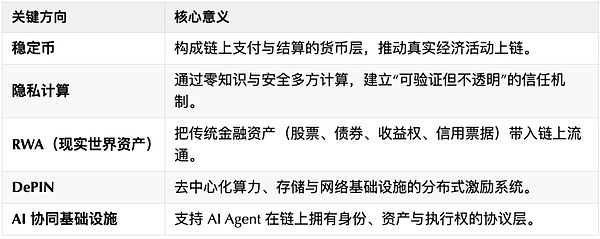
1. Current Situation: Anxiety and Crisis of Web2 Technicians
I found out, add me as a friend and ask meHow to transition to Web3There are more and more people.
There are fresh graduates, engineers who have been working for three to five years, and middle-aged technicians like me who have been working for more than ten years and are beginning to feel uneasy about their career prospects.
Their questions are almost the same:
“Does Web3 still have a chance?”
“Is it too late for me to learn now?”
“The most realistic thing is – how do new people find a job in Web3?”
This anxiety is no accident.In the past ten years, Web2 has built a “certain world” for technical people – stable positions, predictable promotion paths and platform dividends.But as we enter 2024, that certainty is rapidly collapsing.The structural turning point of the Internet industry has arrived, and the wave of AI is making this transition more irreversible.
1. The end of technological dividends
The growth of the global Internet industry is slowing down.In the first half of 2025, global technology companies announced a total of nearly 100 layoffs.94,000 people, hitting a new high in the past three years (Observer, 2025.07).This is no longer a cyclical adjustment, but a fundamental change in industrial logic.
Microsoft’s actions are particularly typical:
In July 2025, Microsoft announced that it would lay off approximately9,000 people, accounting for approx. of the global workforce4%; and in May, it just completed another round over6,000 peopleof layoffs.At the same time, the company clearly requires employees to “must use AI tools” and incorporates them into the performance appraisal system.
This means that even the most stable and resource-advantaged technology giants in the world are actively “using AI to optimize their human resources structure.”The “security of technical positions” formed under the Web2 model is being systematically eroded.
2. The substitution effect of AI
The rise of AI is not just an update of productivity tools, but a rewriting of the definition of “technical work itself.”Stack Overflow’s 2025 Global Developer Survey shows that52% of programmers use AI tools every day(such as Copilot, ChatGPT, Claude, etc.), where18% say AI has significantly changed their job responsibilities.
In other words, AI becomes part of the development process, not optional.
A product that originally required 10 people to collaborate can now be delivered with 3 people plus AI.
The focus of competition for jobs is shifting from “who can write code better” to “who can collaborate with AI more efficiently.”For traditional Web2 technical people, this is a silent “middle layer collapse”:AI-native engineerare on the rise, while purely executive positions are gradually being marginalized.
3. The double-edged sword of platform dependence
The prosperity of Web2 is built on the “platform ecosystem”.Technicians are dependent on App Store, Google, WeChat, Douyin and other systems, but this dependence also meansPersonal output lacks autonomy and asset quality.Data from SensorTower shows that Apple App Store policy adjustments at the end of 2024 will result in approximately12% of independent developers have seen their income plummet, the main income channels of many small and medium-sized teams were instantly cut off.
This risk is common under the Web2 system:
-
Changes in platform rules can directly affect personal livelihoods;
-
The creator’s data and works belong to the platform;
-
Accounts or services may be “reset to zero” if they are banned.
In this structure, no matter how hard an individual works, it is difficult to accumulate transferable and accumulating assets.
4. Reconstruction of skills and income structure
LinkedIn’s “Future of Skills 2025” report states that,AI, blockchain, data analysishas become the fastest growing skill direction, while the growth rate of traditional web front-end skills has dropped to0.3%.At the same time, according to Levels.fyi year-end 2024 data, the average salary of FAANG engineers fell by approximately8%, while AI/LLM related jobs bucked the trend and rose20%+.
This means that technological dividends are shifting from “platform development” to the new field of “intelligent systems + decentralized technology”.Skill transfer is no longer the “icing on the cake” but a “prerequisite for survival”.
5. The root of security is shaken
What these data put together is:
-
Web2’s organizational stability is no longer there;
-
The boundaries of job skills are blurred by AI;
-
Income and growth paths are divorced from platform logic.
More and more engineers, designers, and product people are beginning to have the same questions:
“Can my skills still constitute long-term value?”
“If I don’t rely on the platform, can my output still exist?”
The source of security is shifting from “companies and platforms” to “individuals’ self-evolution capabilities.”
This is the core logic of “Web2 is no longer safe”:
Certainty has migrated from external organizations to individual structures.
The next generation of technicians must rebuild their own certainty at the intersection of AI and Web3.
2. Inflection point: the integration of AI and Web3 era
If the last wave of the Internet (Web2) allowed people to “connect together”, then this wave (AI + Web3) is reconstructingbody of connection——Shift from “platform center” to “intelligent agents and individuals”.
1. Superposition point of technology cycle
The emergence of AI and Web3 is not an isolated event, but the intersection of two exponential curves.
-
AI curve:Generative intelligence represented by LLM (Large Language Model) is realizing “cognitive automation“.
-
Web3 Curve:Decentralized infrastructure represented by blockchain is realizing “value automation“.
When these two curves intersect, a new era interface is formed:
Intelligent individuals can have identities, assets and actions on the chain.
McKinsey estimates in “The Economic Potential of Generative AI” (2025) that AI is expected to contribute to the global economy every year$4 trillion to $7 trillion; and according to Electric Capital’s 2025 Developer Report, Web3 still has more than23,000 monthly active developersContinuously building.This shows that although the two ecologies have different rhythms, they are both enteringPracticalization and integration period.
2. AI: from tool to subject
2023–2025 is a critical stage for the “personalization” of AI.From the initial ChatGPT and Claude to today’s focus on coding/Agent modeCursor, Claude Code, Codex, we have witnessed the evolution of AI from “auxiliary tools” to “autonomous execution agents (Agents)”.
AI is no longer just an assistant to help you write code;Collaborator who makes decisions and executes tasks autonomously:
-
It can automatically write and deploy contracts;
-
Ability to interact with on-chain protocols, execute transactions and manage assets;
-
It can even self-learn and optimize based on the revenue model.
This evolution gave birth to a new concept——AI-native Builder:
Individuals expand production capacity through AI and solidify results through on-chain protocols.
This means that the “developer” of the future will no longer be a single engineer, but a mixture of “people + agents”.
3. Web3: From speculative narrative to structural infrastructure
At the same time as AI, Web3 is undergoing a transformation from a speculative narrative to an infrastructure.In the past, people talked more about “currency price”, but now the focus is turning to “protocol layer capabilities” – those underlying facilities that can support the digital economy in the long term.
Today, the real focus of the industry is focusing on several directions:

Together, these trends illustrate:
Web3 is no longer just a stage for financial innovation, but is evolving into the next generation of Internet.Trusted execution layer (Trust Layer)——A base that allows AI, individuals and the real economy to collaborate freely under a trust mechanism.
4. What will happen when AI and Web3 merge?
We are seeing a completely new system shape:AI generation + Web3 settlement + individual ownership.This structure brings about three levels of transition:

Simply put, AI makes “production” more efficient, and Web3 makes “results” more sustainable.The two jointly promoted a trend——The emergence of individual economies.
AI can allow a person to have a hundred times more production capacity; Web3 allows this production capacity to be confirmed, monetized, and reused.This is the underlying logic behind the rise of the “one-person laboratory” and even the “one-person company” model.
5. Structural opportunities: from platform dividends to protocol dividends
Historically, every technological cycle has been accompanied byRewriting of production relations.From PC to the Internet, from mobile to platform economy, the center of dividends is constantly moving.And this time, the dividend is shifting from “platform dividend” to “protocol dividend”:
-
Platform bonus: Relying on giants and monetizing through traffic;
-
Agreement bonus: Build an open system and participate in value distribution.
In this process, individuals who know how to use AI to build products and use Web3 to confirm the results will become the next generation of “micro production nodes.”Whether you are a developer, designer, or independent creator, you have the opportunity to find new certainties in it.
6. Propositions for the new era
When we say “AI + Web3 is an inflection point”, it is not an abstract slogan, but a realistic structural trend:
-
Fundamental changes in production tools (AI);
-
The value system has fundamentally changed (Web3);
-
The role of technicians is shifting from “passive execution” to “active creation.”
This is not a skill upgrade, but a paradigm shift.
This is the inflection point represented by “AI + Web3 integration”:
AI redefines productivity, Web3 redefines ownership.
When productivity and ownership overlap at the individual level, a new era of technical man begins.
3. The way out: from technical positions to individual nodes
When technology dividends fade and platform certainty collapses, new problems will naturally arise:
“Then how do I transform?”
In the era of integration of AI and Web3, the way out for technical people is no longer to “change jobs” but toReconstruct your own production structure——From passively participating in the platform to actively becoming an “individual node”.
1. From job thinking to system thinking
In the Web2 era, the value of technical people mainly depends on their “positions”: writing code, doing architecture, and running projects.But the arrival of AI allows tasks to be automated, and the emergence of Web3 makes value distribution more open.
The new competition logic is:
It’s not how many tasks you can complete, but how many systems you can build.
The system can be:
-
An automated development pipeline (AI + DevOps)
-
A smart contract protocol (Web3 application layer)
-
A knowledge and tool product (Notion template, Agent, API service)
These systems are not platform dependent;Driven by individuals, assisted by AI, and backed by protocolsself-circulating body.
This is what I am doingSoluno Lab“BuildBlockETFandBlockLeverThe starting point is to make each project a system unit that can run independently, accumulate assets, and be reused.
Technical people need to shift from “doing tasks” to “building machines” and let the system work for them.
2. Phase 1: AI productivity upgrade
In any transformation journey, the first step is alwaysMaster the AI tool stack.It determines whether you have the foundation for “hundred times production capacity”.
-
text and cognitive layer: ChatGPT, Claude, Perplexity – for thinking, analysis, decision-making and writing;
-
Coding and R&D layer: Cursor, Claude Code, Codex – used for code generation, debugging, documentation and testing;
-
Creativity and expression level: Midjourney, Runway, Figma AI, ElevenLabs – for visual and multi-modal creation.
My own work is almost a microcosm of this system.BuildingBlockETFandBlockLeverAt that time, I used Claude Code to help me analyze and generate complex contract logic every day.In my daily writing, I also use ChatGPT to help me polish my copywriting.AI has not replaced me, but has allowed me to focus more on architecture and creation.
Mastering these tools is not about showing off your skills;Embed AI into your personal workflow: Write requirements → Generate code → Automatic testing → Output documents → Publish content.Do this and you are no longer an “executor” but an “AI orchestrator”.
3. The second stage: Web3 technology and asset-based thinking
After you can use AI to produce efficiently, the second step is: let the outputConfirmed rights, benefits and continuity.This is what Web3 thinking is trying to solve.
-
learning level: Master smart contracts (Solidity), EVM logic, wallet interaction, and on-chain deployment;
-
product level: Understand the token model, protocol mechanism, oracle and governance system;
-
thinking level: Realize that “your code, your models, your content” can all become aAsset Unit.
Technical people are no longer just developers, but asset issuers, protocol designers, and node operators.AI allows you to create efficiently, and Web3 allows you to own and monetize it.The combination of these two forms“Personal Sustainable System”prototype.
4. The third stage: individual productization and branding
When you can produce, confirm authority, and circulate, you will enter the third stage:individual productization.This means that you are no longer attached to a job, but rather building your own “micro-ecosystem.”
Typical paths include:
-
Personal brand products: Technology blogs, courses, consulting, SaaS tools;
-
On-chain product projects:Micro-protocol, NFT series, AI Agent-as-a-Service;
-
social economy experiment: One-person company DAO, tokenized membership, revenue sharing model.
The competitiveness at this time does not lie in how many technologies you have mastered, but in:
Can you precipitate your knowledge, algorithms, and experience into a “reusable structure”?
Individuals are nodes, and nodes are brands.When you have your own protocol, code base, product matrix, and user network, you no longer need a “company” to define your value.
5. Establish new “certainties” inwards
In the Web2 era, certainty comes from the organization; in the AI + Web3 era, certainty comes fromStructurally self-consistent individual system.
AI allows you to have the “leverage of productivity”, and Web3 allows you to have the “leverage of value distribution”.When the two are combined, you have the ability to survive, create and accumulate in any environment.
This is the true meaning of moving from “position” to “node”:
You are no longer part of the system but its creator.
Summary
The wave of AI + Web3 will not eliminate everyone, but it will eliminate everyonePeople who lack the ability to systematically upgrade themselves.For technical people who are willing to learn, practice and build, this era is the best era.
“You don’t need to join a big company to change the world. You can use AI + Web3 and become a small company itself.”
4. Path: Transformation Roadmap from 0 to 1
Understanding trends is one thing, transforming them is another.Moving from a Web2 technical position to the AI + Web3 era does not mean starting over from scratch;progressive iterationComplete the reconstruction of skills and thinking.
A realistic and feasible path is to advance in three stages:Toolization → protocolization → productization.
1. Phase 1: Toolization—AI-driven productivity reconstruction
Goal: Make AI part of your workflow.
Key actions:
-
Use ChatGPT / Claude / Perplexity as a “cognitive assistant” and let it participate in thinking, structure design and writing;
-
Integrate Cursor / Claude Code / Codex into the development environment and reconstruct your development process (Requirements → Code → Test → Documentation);
-
I involve AI in my workflow almost every day, from automatically generating test scripts, updating documentation, to assisting with code refactoring and deployment.To me, AI is no longer just a tool, but a part of the R&D system.
Metrics:
When you can use AI tools to complete 80% of the work that originally required manual collaboration, you will have the prototype of an “AI-native individual”.
2. Phase 2: Protocolization—Learning Web3 structure and value logic
Goal: Understand and be able to build a system that can be confirmed, settled, and combined.
Key actions:
-
Learn smart contract languages such as Solidity/Rust/Move;
-
Understand on-chain components: wallet (EVM/EIP standard), liquidity protocol (Uniswap/PancakeSwap), oracle (Chainlink/Pyth), indexing service (The Graph/SubQuery);
-
On-chain experiments in the form of a minimum viable product (MVP), such as the one I built at Soluno LabBlockETF(on-chain index protocol) orBlockLever(Leverage Lending Agreement), starting from the core functions, first verify the contract logic and economic model;
-
Learn how to interact with the front-end through Subgraph and API to implement a complete DApp process.
Metrics:
When you can independently complete an on-chain project and understand its economic incentive structure, you will have the basic capabilities of “Web3-native Builder”.
3. Stage 3: Productization – Build your own “individual system”
Goal: Precipitate personal abilities into reusable, tradable, and sustainable products.
Key actions:
-
Integrate your AI + Web3 experiments into reusable modules, such as open source libraries, smart contract templates, educational content, and automation tools;
-
Use GitHub/Mirror/X (Twitter) and localized channels for dissemination and verification;
-
Build a “personal asset structure”: project documents, code warehouse, protocol deployment records, content system;
-
Try to create a closed loop of income: courses, consulting, tool subscriptions, and on-chain revenue sharing.
Metrics:
When your system can continue to create value even when you are not online, you have completed the transformation from “position” to “node”.
4. Key mentality: incremental evolution, not one leap
Transformation is not a one-time event but an ongoing evolutionary process.The real risk is not “failure to learn” but “staying in the old paradigm”.
You don’t have to master every new technology at once, but you do have to keep yourself on track to continuously iterate.
Treat every learning, experiment, and output as part of building an “individual system”. As the tools evolve, your structure will automatically upgrade.
5. From skill tree to ecological map
The traditional skill tree is vertical: from elementary → intermediate → advanced; while the skill map of AI + Web3 is meshed: cognition, tools, protocols, content, and communities are interconnected.
This means your learning path should also be multi-dimensionally parallel:

Summary
The transformation from Web2 to AI + Web3 is not about escaping from the old world, but about reconstructing your own structure in the new world.AI gives you “efficiency leverage”, Web3 gives you “ownership leverage”, and productization gives you “compound interest leverage”.
The real way out is not to find a new job, but to build a personal system that can evolve itself.
5. Conclusion: From “insecurity” to “new certainty”
Looking back over the past few years, we have witnessed a sea change in the entire technology world.AI has brought about a leap in efficiency, Web3 has reshaped the way value is distributed, and the order of Web2—jobs, platforms, companies—is losing its certainty.
This kind of insecurity is felt by almost every technical person.You may be asking:
“Am I still up to date?”
“Will what I do still be needed?”
But the truth is, true certainty never exists in the outside world, it’s always hidden within youDo you have the ability to create independently and evolve yourself?among.
1. Certainty comes from structure, not position
In the era of AI + Web3, a person’s structure is determining his certainty.AI allows you to complete work that required a team in the past; Web3 allows you to confirm rights, distribute profits, and accumulate long-term assets.When these two abilities come together in one person, you are no longer attached to the platform, but become aIndividual nodes with complete economic cycles.
This is not idealism, but a realistic trend.More and more people are using AI and on-chain tools to build their own micro-systems: some make products, some make content, and some make protocols.What they have in common is:
Instead of looking outside for certainty, use the system to make yourself certain.
2. The biggest opportunity for technical people is to redefine themselves
From Web2 to AI + Web3, the core of this transformation is not “changing the track”, but “reconstructing ourselves”:
-
Shift from job role to system builder;
-
Shift from executing tasks to creating mechanisms;
-
From dependent organizations to independent nodes.
This transformation is exactly what I am doing in “Soluno Lab” The path that has been practiced.BlockETFandBlockLeverIt is not the end of the product, but the iterations of systematic individuals.They show me:One person can also build complex systems, push projects online, and form a compound interest ecosystem.This is our “new certainty”.
3. The future belongs to those who have structure
The future no longer belongs to the most diligent people, but to thePeople who can build systems.AI will continue to amplify your leverage, Web3 will continue to solidify your results, and your task is to continuously upgrade this “personal system”: make it more automatic, more open, and more sustainable.
While others are still worried about “whether their position is safe,” you are already using your own system to create a sense of security.
Security no longer comes from employers, markets or platforms, but from whether you can evolve yourself.
AI + Web3 is not a torrent, but a tool.The real certainty comes from whether you dare to use them to build your own world.
Postscript
What I write down is not to describe a vision of the future, but to record a current reality.AI has entered our daily life, and the infrastructure of Web3 is gradually improving.
When the boundaries of the times are redrawn, the best way for technical people to respond is not to fear, but to create.
We start from insecurities and end up finding ourselves in structures of certainty.







